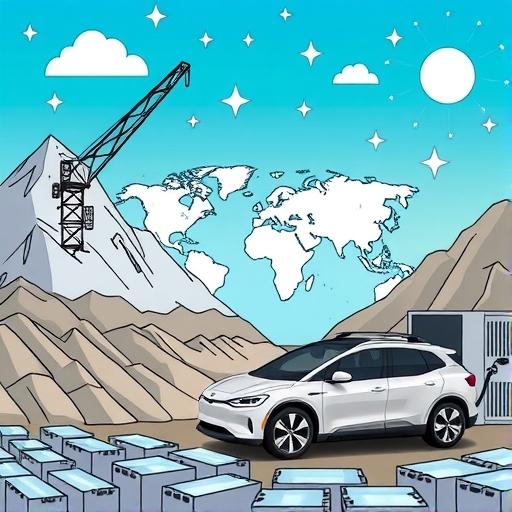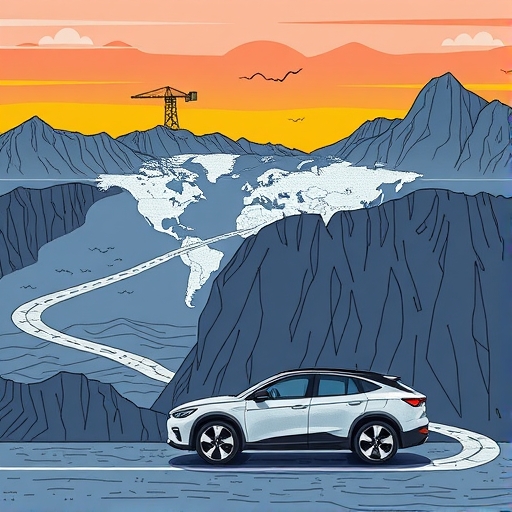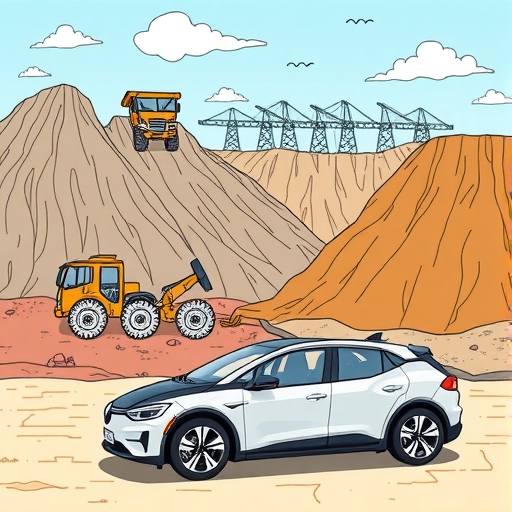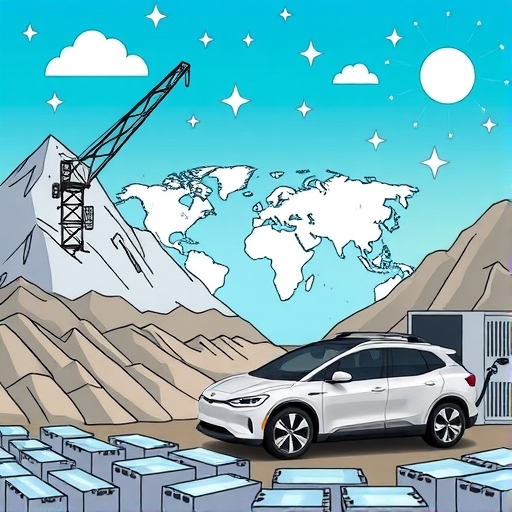The Great Lithium Paradox: Understanding Today’s Surplus and Tomorrow’s Potential Shortage
Think back just a couple of years. You likely heard about the soaring prices of lithium, the essential “white gold” powering our electric vehicle future. There was talk of scarcity, bidding wars, and a frantic race to secure supply. Analysts predicted persistent deficits, and investors poured capital into exploration and mining projects worldwide. It felt like the dawn of a perpetual bull market for this critical mineral.
But fast forward to 2024 and 2025, and the narrative has dramatically flipped. We’ve witnessed a sharp, almost unprecedented, correction in lithium prices, driven by a surge in supply that has significantly outpaced even the robust growth in demand. This creates a fascinating paradox: how can a market so vital for the accelerating global energy transition swing so wildly from perceived shortage and record highs to a significant supply surplus and multi-year price lows? And what does this mean for you, whether you’re an investor watching commodity markets, a player in the battery or automotive industries, or simply someone interested in the future of clean energy?
In this analysis, we will delve into the dynamics of the global lithium market, dissecting the reasons behind the current oversupply, exploring the complex interplay of economic and geopolitical factors, understanding the dominant players, and peering into the future to anticipate the potential shifts that lie ahead. We aim to provide you with a comprehensive understanding of this volatile yet strategically crucial market.

- The global lithium supply has surged dramatically, impacting market prices.
- Investment trends and geopolitical dynamics play critical roles in shaping the industry.
- The demand for lithium is driven by the growing electric vehicle and energy storage markets.
The Anatomy of the 2024 Lithium Supply Surge
Let’s begin by examining the fundamental shift that occurred in 2024: the rapid expansion of global lithium supply. Based on the provided analysis, the world witnessed a remarkable increase in production, with global lithium supply surging by over 35%. This level of growth in a single year for a major commodity is substantial and directly responsible for reshaping the market landscape.
Where did this significant volume of new supply originate? The analysis highlights dramatic contributions from several key regions. Africa, often cited as a future resource frontier, experienced a near five-fold jump in its lithium output. This surge was so significant that Africa contributed a substantial 30% of the total new global production brought online in 2024. Simultaneously, Latin America, home to the traditional “Lithium Triangle,” also saw a robust increase, with its supply rising by 65%.
| Region | Supply Increase (%) | Contribution to Global Production (%) |
|---|---|---|
| Africa | 500% | 30% |
| Latin America | 65% | Varies |
This underscores a critical dynamic in the mining sector: bringing large-scale projects online requires significant time and capital investment, often spanning many years. However, once these projects reach production capacity, they can quickly inject massive volumes into the market, fundamentally altering the supply-demand balance. The 2024 surge is a testament to the successful culmination of investment decisions made years prior, perhaps fueled by the price boom of 2021-2022, now coming to fruition simultaneously.
Why Prices Plunged: Demand vs. Oversupply Dynamics
The immediate and most visible consequence of this unprecedented supply growth was a sharp decline in prices. While global demand for lithium remained strong, increasing by a healthy 30% in 2024 (primarily driven by the Electric Vehicle sector, with significant contributions from Energy Storage Systems), it simply couldn’t keep pace with the rate at which new supply hit the market. This differential – 35%+ supply growth versus 30% demand growth – created a significant market surplus. If you follow commodity markets, you know that a sustained surplus almost inevitably leads to price erosion.
The analysis confirms this expected outcome. We saw Lithium Carbonate Equivalent (LCE) prices tumble dramatically from their speculative highs of 2022. By June 2025, LCE prices were hovering around USD 12,000 per tonne. Similarly, battery-grade Lithium Carbonate in China, a benchmark market given its dominance in processing and consumption, dropped to approximately CNY 60,400 per tonne. These figures represent a four-year low, a stark contrast to the frenzied, near-record highs observed just a couple of years prior. The speed and magnitude of this price correction caught many market participants off guard, highlighting the inherent volatility of commodity markets influenced by both physical supply constraints and speculative sentiment.

Decoding Production Resilience: Operating Through the Downturn
Now, here’s where the situation presents a paradox that requires deeper understanding. In a typical commodity market, when prices fall below production costs, mines usually respond by shutting down or significantly curtailing output. This reduction in supply helps to rebalance the market and stabilize or even lift prices. However, in the current lithium landscape, many operations, particularly those with strong strategic backing or integrated business models, have continued to produce despite operating at thin margins or even potential losses. Why is this happening?
The reasons are multi-faceted and strategic, extending beyond simple cost economics. Firstly, many of these mines are connected to downstream operations, often controlled by major battery manufacturers or chemical processors. Companies like Ganfeng Lithium or Zhejiang Huayou Cobalt, which have investments in mines, are also major players in refining and battery materials. For them, the strategic imperative might be ensuring a consistent and low-cost supply for their core battery business, even if the mining segment isn’t currently profitable on a standalone basis. Think of it like a large manufacturing conglomerate that owns a raw material supplier – they might tolerate lower profits from the supplier if it significantly reduces costs for their main product line.
Secondly, companies are often driven by strategic goals related to retaining or expanding market share. In a downturn, continuing production allows them to maintain their relationships with customers and position themselves to benefit from a future market recovery. Shutting down a complex mining operation is also technically challenging and expensive. Restarting involves significant costs and time, often resulting in operational delays. Therefore, it can sometimes be more ‘economic’ in the short term to continue operating, even at a loss, to avoid the costs and disruptions associated with a temporary closure.
Finally, geopolitical objectives play a significant, if sometimes understated, role. For nations prioritizing energy security and control over critical mineral supply chains, maintaining domestic or strategically controlled foreign production might supersede immediate profitability concerns, especially when supported by government backing or long-term strategic planning, as seen with certain entities mentioned in the analysis.
China’s Hegemony: From Mine to Battery
To truly grasp the complexities and competitive dynamics of the global lithium market, you must understand the central and powerful role of China. The data makes it unequivocally clear: China holds a position of remarkable dominance across the entire lithium value chain, presenting a unique challenge for other nations seeking to build independent supply chains.
Consider these figures provided by the analysis: China controls approximately 70% of global lithium refining capacity. This is a critical bottleneck. Raw lithium, whether from hard-rock spodumene or brine deposits, needs to be processed into battery-grade chemicals (like lithium carbonate or lithium hydroxide) before it can be used in battery production. China’s command over this refining stage gives it immense leverage over the global supply of usable battery materials.
Furthermore, China is the world’s largest consumer of lithium, driving over 75% of global demand in 2024. This demand is fueled by its world-leading position in battery manufacturing, home to giants like CATL and BYD. These companies are not just major battery producers; they are the primary anchors for global lithium consumption, dictating material specifications and indirectly influencing global flows.
| Aspect | China’s Position | Global Impact |
|---|---|---|
| Refining Capacity | 70% | Critical influence on pricing and availability |
| Global Demand | 75% | Drives industry development |
This isn’t accidental. China has strategically invested heavily in securing raw material supply globally to feed its processing and manufacturing powerhouses. We see Chinese companies actively acquiring or partnering in mining assets across Africa (like Zimbabwe, which rapidly ascended to become the 4th largest supplier in 2024, largely thanks to Chinese investment in mines and processing facilities) and Latin America, including significant interests in countries like Australia, a major hard-rock producer. This proactive, long-term global investment strategy, sometimes linked to broader geopolitical initiatives like the Belt and Road Initiative, solidifies China’s lead and presents a significant competitive hurdle for other nations seeking to build their own resilient supply chains from the ground up.
The Geopolitical Race for Lithium: US and EU Strategies
Given China’s powerful and integrated position across the lithium value chain, it’s no surprise that other major economic blocs, particularly the United States and the European Union, are actively striving to build more independent and resilient lithium supply chains. For you as an investor or industry observer, understanding these geopolitical forces is as important as understanding physical supply-demand balances or price charts. These efforts are driven by concerns over energy security, economic competitiveness, and reducing reliance on potentially vulnerable supply routes.
In the United States, for instance, we’ve seen trade policy measures aimed at bolstering domestic manufacturing and influencing supply chains. The analysis mentions the imposition of significant 30% tariffs on imported battery products. These tariffs are designed to protect and encourage the development of domestic battery production capacity. However, crucially, key battery minerals like lithium are currently exempt from these tariffs. Why the exemption? The analysis points to US reliance on imports for achieving its clean energy targets. This highlights a strategic dilemma: the need for critical minerals to build out domestic clean energy infrastructure versus the desire for complete supply chain independence. Past administrations have highlighted this reliance, with efforts like the Trump administration’s Executive Order initiating investigations under Section 232 into critical mineral imports based on national security grounds.
Meanwhile, the European Union faces similar challenges. While the EU has established regulatory frameworks aimed at promoting responsible sourcing and recycling of critical minerals and engaged in bilateral agreements with producing countries like Chile and Argentina to potentially diversify supply, both the US and EU face substantial hurdles. A significant challenge is the comparative lack of investment in mining and processing capacity within their own borders or under the control of their companies, especially when compared to the scale, speed, and state-backed nature of China’s global resource acquisition strategy. The long lead times required to develop new mining and refining capacity further complicate these efforts. The race to secure domestic or politically aligned-sourced lithium supply is very much on, a critical component of broader energy security and industrial strategy.
Emerging Supply Frontiers and Technological Advances
While established lithium producers like Australia, Chile, and Argentina remain foundational pillars of global supply, the recent surge in output and the future potential for diversification are significantly boosted by emerging frontiers and the development of new extraction technologies. We saw earlier the dramatic numbers for Africa and Latin America in 2024. Let’s look closer at some specific developments mentioned.
Africa’s remarkable 5x jump in output in 2024 wasn’t a single isolated event but reflects the culmination of investments in various projects. Countries like Zimbabwe have rapidly ascended the ranks, becoming the 4th biggest lithium supplier globally, largely fueled by strategic investments, particularly from Chinese entities. Other African nations like Namibia and potentially the Democratic Republic of Congo are also becoming increasingly relevant in broader critical mineral discussions and could contribute more significantly in the future.
In Latin America, the 65% increase reflects not only expansions within the traditional “Lithium Triangle” region (encompassing parts of Chile, Argentina, and Bolivia, which holds significant known reserves) but also the advancement of new production methods. Argentina, for example, is seeing projects like Eramet’s Centenario project advance. What’s notable about Centenario is its planned use of Direct Lithium Extraction (DLE) technology. DLE is a suite of technologies aimed at extracting lithium directly from brines (salty underground water deposits) with potentially greater efficiency, higher recovery rates, and a smaller environmental footprint (e.g., less reliance on large evaporation ponds) compared to traditional methods, although DLE also comes with its own set of technical and scaling challenges. These new sources, coupled with technological advancements like DLE, are vital for diversifying global supply away from current concentrations and potentially increasing the speed at which new resources can be brought to market, though DLE is still in its relatively early stages of widespread commercial deployment.
Key Projects Shaping Future Capacity and Partnerships
Looking ahead, the future supply pipeline isn’t theoretical; it’s dependent on specific projects around the world coming to fruition. The analysis highlights several key initiatives that are either already contributing to the recent supply surge or are poised to significantly impact future capacity and demonstrate the nature of strategic partnerships in the industry.
In the United States, the Rhyolite Ridge project in Nevada, spearheaded by Ioneer Ltd, is particularly noteworthy for its potential impact on domestic US supply. The project secured a significant conditional commitment for a loan from the US Department of Energy, signaling governmental support. Once operational, Rhyolite Ridge has the potential to quadruple domestic US lithium supply from its current levels, a critical step towards reducing import reliance for the US clean energy sector.
In Argentina, as mentioned, Eramet’s Centenario project represents a significant investment utilizing DLE technology on a commercial scale within the Lithium Triangle. The success and scalability of such DLE projects will be closely watched as they could offer a pathway to unlock vast brine resources more sustainably and rapidly.
In Australia, the world’s largest producer of mined lithium (primarily from hard-rock spodumene deposits), significant projects continue to develop. Liontown Resources’ Kathleen Valley Mine, for instance, secured support from LG Energy Solution, a major South Korean battery manufacturer, illustrating the downstream industry’s proactive approach in securing raw materials. Similarly, the Mt. Marion mine, operated by Mineral Resources (MinRes), is co-owned by China’s Ganfeng Lithium, one of the world’s largest lithium chemical producers. These partnerships highlight the intricate web of global supply chains, where companies from different continents collaborate to bring lithium from the ground to the final battery cell.
| Project | Location | Significance |
|---|---|---|
| Rhyolite Ridge | Nevada, USA | Could quadruple domestic lithium supply |
| Centenario Project | Argentina (Lithium Triangle) | Utilizes DLE technology for efficient extraction |
| Kathleen Valley Mine | Australia | Significant collaboration with LG Energy Solution |
Tracking the progress, financing, and operational ramp-up of these and other major projects globally is crucial for anyone attempting to forecast how much lithium will *actually* be available to meet projected demand in the coming years. Delays or technical challenges at any of these key sites could have ripple effects across the market.
Impact on Downstream Industries and Industry Structure
While the sharp decline in lithium prices has created headwinds for mining companies, it represents a significant advantage for industries further down the value chain. For battery manufacturers, lithium is often the largest single component cost, accounting for a considerable percentage of the total battery cell price. The substantial decrease in lithium prices provides considerable cost relief for these producers.
This reduction in battery production costs is, in turn, good news for the Electric Vehicle (EV) sector. Lower battery costs can translate into more competitive EV prices for consumers, potentially accelerating the rate of EV adoption globally. As the analysis notes, demand growth in 2024 was strongly driven by the EV sector, and lower battery costs help maintain that momentum.
Beyond cost benefits, the low-price environment has also acted as a catalyst for industry consolidation. When prices are low and margins are squeezed, weaker players or projects that are marginal at lower price levels become vulnerable. Stronger companies with deeper pockets, more efficient operations, or strategic imperatives (like securing supply) see opportunities for acquisition or mergers. The analysis notes industry consolidation has occurred, citing an example involving Rio Tinto’s participation related to Arcadium Lithium, a major lithium chemical producer formed through a merger. This consolidation reshapes the competitive landscape, potentially leading to larger, more integrated, or more geographically diversified lithium companies, which can have implications for future supply and pricing dynamics.
Navigating Price Volatility and Future Investment Hurdles
What about the immediate future for prices? Market analysts, such as those at SMM (Shanghai Metals Market), are predicting that price volatility is expected to continue throughout 2025. This shouldn’t be surprising; commodity markets influenced by rapid shifts in supply and strong underlying demand often experience periods of significant price swings as they search for equilibrium. The current surplus could take time to be fully absorbed, and any disruptions or unexpected shifts in demand could trigger rapid price reactions.
This volatility, combined with the currently depressed price levels, presents significant challenges for attracting investment into new lithium mining and processing capacity. Developing a new world-class lithium project is a multi-year, multi-billion-dollar undertaking. Investors and financiers need confidence in long-term price levels to justify committing such substantial capital. The current uncertainty, where prices are far below the levels seen a couple of years ago and forecasts are mixed beyond the immediate surplus period, makes those crucial investment decisions much harder.
If sufficient investment doesn’t flow into sanctioning and developing new projects *now*, despite the current surplus, it creates the conditions for potential supply bottlenecks down the road. Given the long lead times – often 5 to 10 years or even longer – required to bring a new discovery through feasibility studies, permitting, financing, construction, and into full production, a period of under-investment during times of low prices can quickly lead to insufficient supply capacity when demand continues its upward trajectory later in the decade.
The Long-Term Outlook: From Surplus to Potential Shortage
This brings us to perhaps the most critical takeaway for you as an investor or observer interested in the long-term future of this market: the long-term outlook appears starkly different from the current reality. While we are currently navigating a significant lithium surplus and depressed prices, multiple analyses point towards potential supply shortages in the not-so-distant future. This is the heart of the lithium paradox.
Forecasting organizations, drawing on projected demand growth rates for EVs and ESS, anticipate a fundamental shift in the supply-demand balance. The Raw Materials Information System (RMIS), for example, predicts that demand could exceed supply after 2029 or 2030 (though it notes graphite as an exception, suggesting varying dynamics for different battery components). More broadly, the International Energy Agency (IEA), a respected authority on energy markets, projects that potential shortages could emerge between 2030 and 2040 if current investment trends and project pipelines do not accelerate significantly.
How can this forecast of future scarcity exist alongside today’s glut? It’s because the projected trajectory of demand growth, primarily driven by the accelerating global transition to electric mobility and the increasing deployment of grid-scale and residential Energy Storage Systems, is incredibly steep over the coming decade. Forecasts indicate that the amount of lithium required globally will continue to climb rapidly year after year. While current supply capacity is temporarily ahead of demand, the existing pipeline of *committed* new projects may not be sufficient to meet the steeper demand curve projected for the early to mid-2030s. As mentioned earlier, the long lead times for new projects mean that investment decisions need to be made *years* in advance of when the material is needed. A period of low prices and uncertain investment now could delay the development of the capacity required in the future, creating the conditions for the projected deficits.
Conclusion: Strategic Imperatives in the Lithium Age
In conclusion, the global lithium market presents a complex and dynamic picture, currently characterized by a fascinating paradox. We are navigating a period of notable supply surplus and sharply lower prices in 2024-2025, a significant departure from the perceived scarcity and record highs of 2022. This surplus, fueled by rapid production growth outpacing strong but slightly slower demand growth, offers welcome cost relief to battery manufacturers and, by extension, the burgeoning EV sector.
Yet, this immediate reality is overshadowed by long-term forecasts from respected organizations like the IEA and RMIS, which project potential supply deficits within the next decade (post-2029/2030 or 2030-2040). This highlights the inherent challenge of matching the long development cycles of mining and refining capacity with the exponential, multi-decade trajectory of demand growth driven by the global energy transition.
China’s enduring strategic dominance across the lithium value chain, from resource acquisition and processing to its world-leading battery manufacturing capacity, remains a defining feature of this market. This dominance fuels a global geopolitical race as other nations, particularly the US and EU, strive for greater supply chain resilience and independence, facing hurdles related to investment levels and competition for global resources. The current low-price environment has also triggered industry consolidation, reshaping the competitive landscape.
For anyone involved in or observing this market, understanding this intricate interplay of short-term supply-demand cycles, strategic national interests, technological advancements like DLE, and the critical need for sustained long-term investment in future capacity is paramount. The global lithium market is not merely a cyclical commodity market; it is a strategically vital component of the future global economy and energy landscape. Its inherent volatility and the contrasting short-term surplus with long-term potential shortage underscore the complexities and strategic imperatives facing governments and corporations navigating the Lithium Age.

world supply of lithiumFAQ
Q:What caused the recent surplus in lithium supply?
A:The surplus is primarily due to a rapid increase in global lithium production outpacing the growth in demand.
Q:How does China dominate the lithium market?
A:China controls about 70% of global lithium refining capacity and drives over 75% of global demand.
Q:What are the long-term projections for lithium supply?
A:Many analysts predict potential supply shortages could emerge between 2030 and 2040, depending on investment trends and production capabilities.

留言